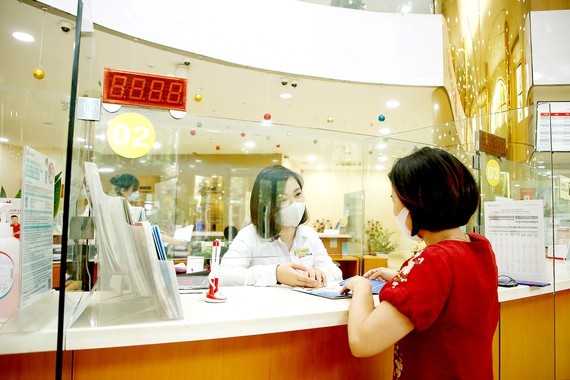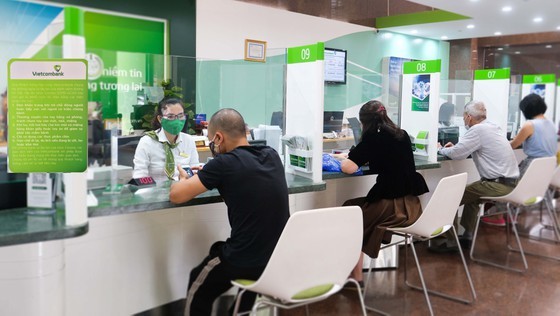
Deputy Governor of Vietnam State Bank Dao Minh Tu reported in the meeting to introduce new missions for banks in 2022 that due to the unexpected and grave Covid-19 outbreak, bad debts of banks in Vietnam went up significantly in 2021 to even more than 8 percent, compared to the set goal of under 3 percent.
Statistics reveal that the absolute bad debt balance of 27 commercial banks at the end of the third quarter last year reached VND111,000 billion (approx. US$4.9 billion), a rise of 26 percent compared to the beginning of the year, mostly due to businesses being unable to pay back during the harsh time of Covid-19 pandemic. Meanwhile, state-owned commercial banks are facing the same situation because they account for the majority of the industry’s total credit.
For instance, the bad debt rates of Vietcombank and Vietinbank doubled to reach 1.1 percent and 1.66 percent, respective. In particular, group 4 (doubtful debt) of these banks experienced increases by 14 times and 10 times correspondingly, while Vietcombank’s group 5 (uncollectable debt) saw a dramatic rise of 45 percent.
The private commercial banks with the highest bad debt rates are LienVietPostBank (rising by 10 percent to be at VND2,700 billion or $118.7 million in comparison with the start of 2021), Techcombank (41-percent increase to VND1,820 billion or $80 million), and NamABank (148-percent increase to VND1,849 billion or $81.3 million).
The good news is most banks have already made record-high bad debt provision, along with the stable real estate market having positive liquidity. Therefore, they can comfortably handle these debts as well as unexpected situations that might happen in the upcoming time.

However, this provision itself has eaten away banks’ profits, especially in the third quarter of 2021 in spite of the positive accumulated profit for the first three quarters.
Vietcombank’s leaders shared that since it is the first to make a 100 percent provision for the restructured loan in accordance with the State Bank’s regulation, its overall profit in 2021 is obviously affected. In fact, its profit before tax in the third quarter last year was only a 15.2-percent increase, much lower than those of private commercial banks. Yet in the long term, it will benefit from this action, especially as the pandemic is still unpredictable.
Securities companies commented that these bad debts are still under control. In addition, although group-2 bad debts grew in the third quarter, restructured loans are expected to turn back to normal when businesses resume their operation.
At present, commercial banks are adopting the State Bank’s Circular on reducing, postponing, and restructuring supports for enterprises to maintain the economic flow. As the real status of debts is not fully revealed, they are classified as sub-standard ones and have a high chance of becoming bad debts.
Deputy Governor Tu stressed that the Vietnam State Bank is going to implement solutions to control and handle existing bad debts while minimizing new ones. Simultaneously, it will closely supervise operations of credit organizations, particularly in high-risk aspects, in order to maintain the bad debt rate of under 3 percent.
Accordingly, it will prioritize credits for social accommodation construction projects but will strictly monitor those in the fields of securities and real estate or those for businesses with unhealthy behaviors.
General Secretary of the Banking Association Nguyen Quoc Hung suggested legalizing bad debt handling processes to strengthen the effectiveness of institutional work, since Resolution No.42/2017/QH14 by the National Assembly will expire in a few months. He recommended either extending the validity of this resolution or introducing new laws for bad debt handling so that banks and related state agencies have a suitable, strong legal tool to work together to reduce bad debts.
Dr. Le Xuan Nghia – member of the National Financial and Monetary Policy Advisory Council praised that despite the record-low economic growth rate last year, the State Bank was able to successfully control the national inflation rate and stabilize the macro-economy.
To help businesses to overcome difficulties, many banks have used their own profits to lower their loan interest rate. In the upcoming time, when the State Bank stops the policy to postpone debts and restructure loans, many of them will turn to bad debt which require more bank provisions. This means an even lower bank profit.
Therefore, he suggested that in 2022, the State Bank should complete the tools for monetary policy management in a more market-oriented manner. Simultaneously, it is necessary to gradually reduce debt postponing packages and to ask banks to increase their own provision, to identify bad debts. Those packages should only be used for laborers, while businesses can receive the interest rate decrease package and financial support from the budget.
























